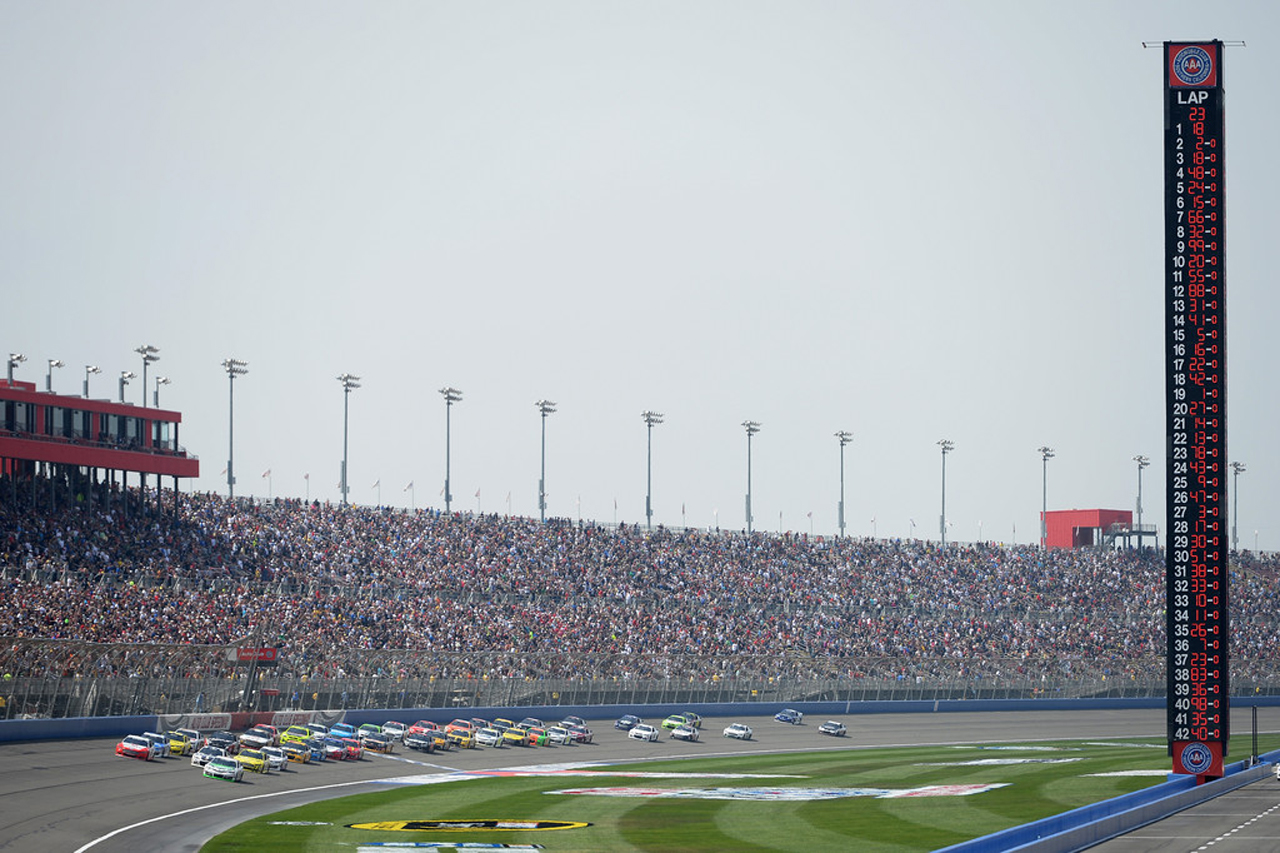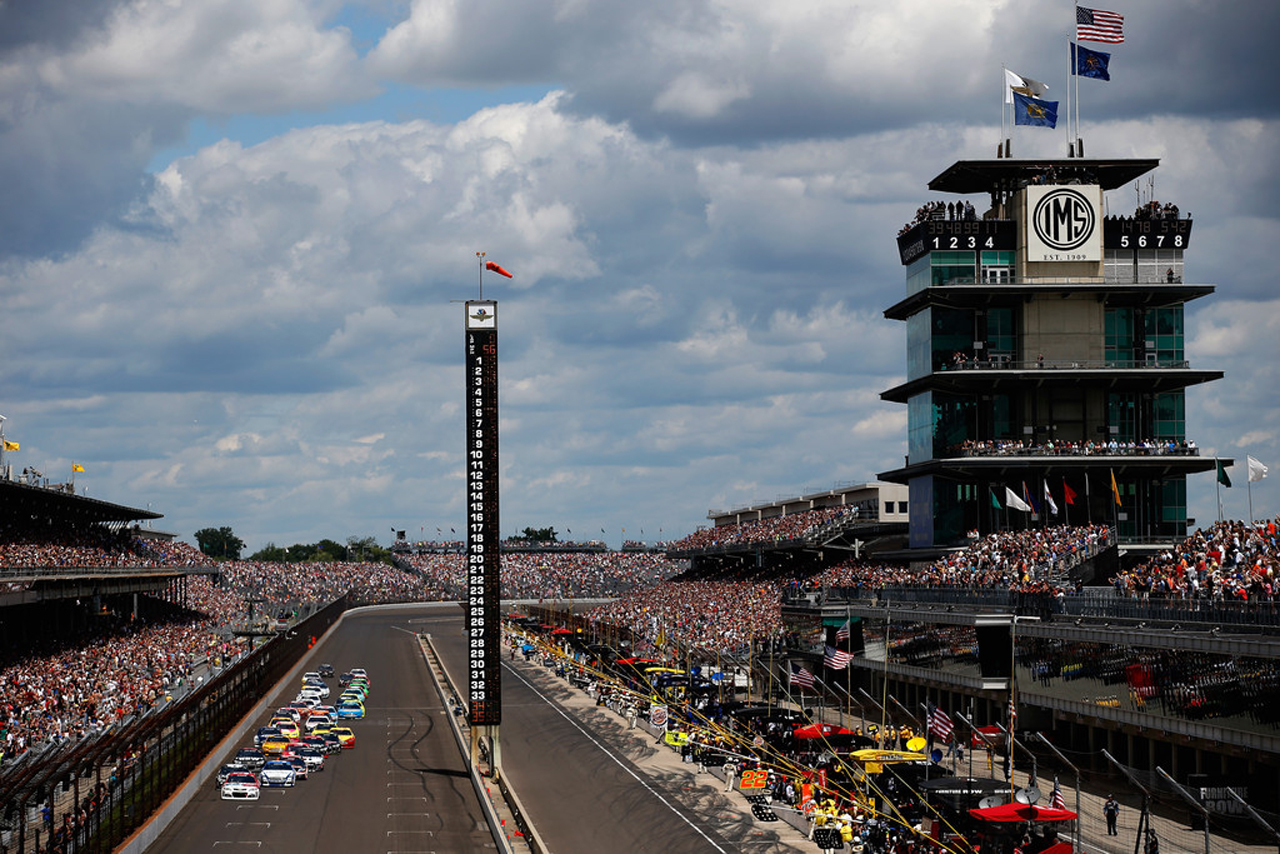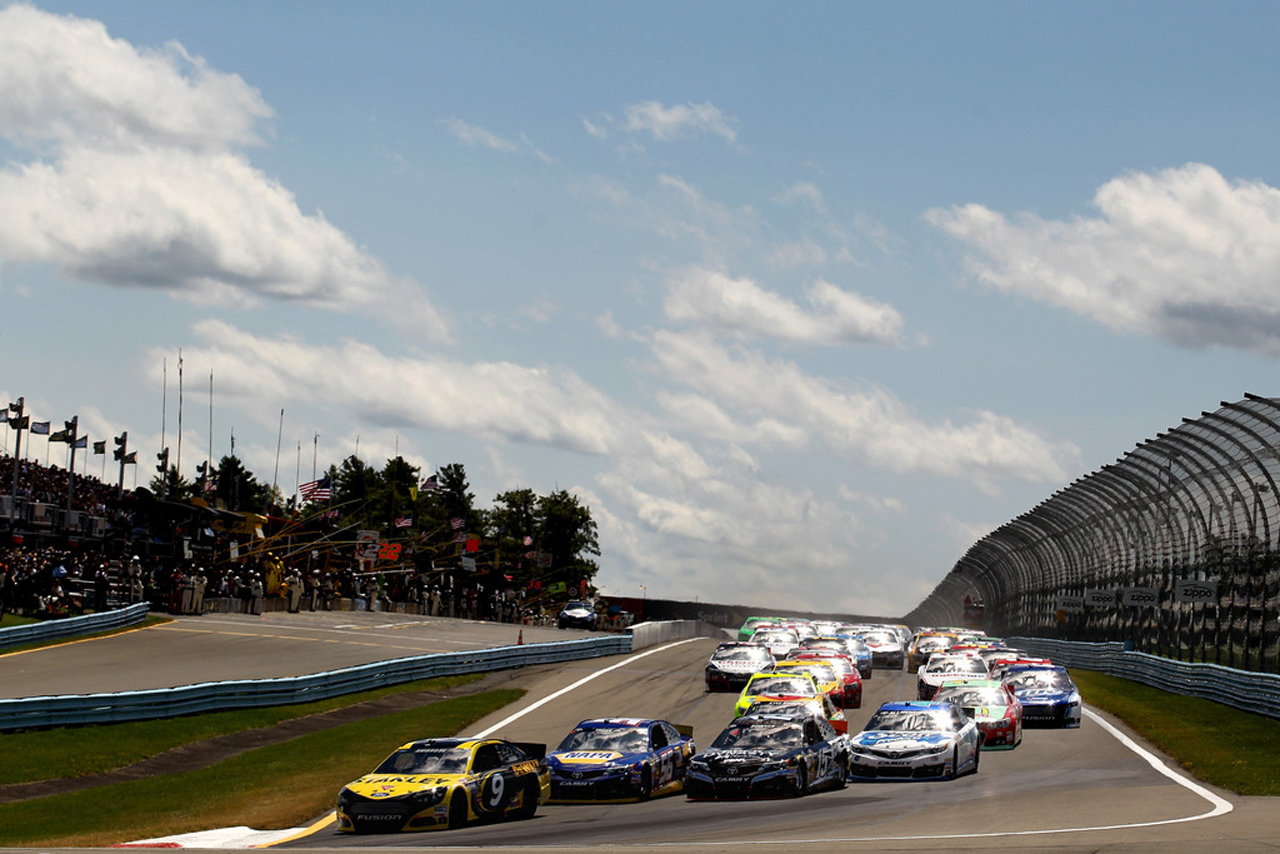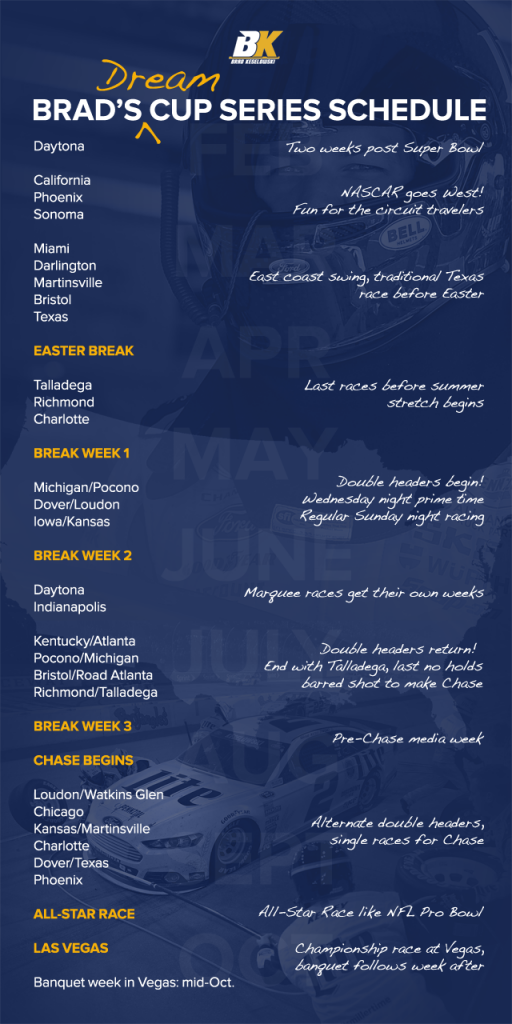Roughly three weeks ago, after a few rainouts and about eight races in, I read an Associated Press article that discussed how much NASCAR has changed in recent years. It was a great piece. As it pointed out, we’ve changed nearly everything. We’ve changed the Chase. We’ve changed the cars. We’ve changed the points.
The only thing that hasn’t changed dramatically over the last 10 to 20 years, the article pointed out, was the schedule. That begged the question: Why is the schedule so sacred? Everything else has been cut, changed, chopped, and rebuilt. Why not that?
It’s a great conversational point, and honestly, no one has really posted a great idea of how to make it better. You hear fragmented ideas like, “We should move this race to this date,” but you never get an all-inclusive idea.
The article got me thinking.
Why is the schedule so sacred? Everything else has been cut, changed, chopped, and rebuilt. Why not that?
So over the Easter break, I sat down and tried to brainstorm something that was all-inclusive. What follows is what I came up with. Before I get into it, I want to make it clear: I understand that there are many reasons why the schedule is the way it is currently. I’m not trying to disrespect any of the parties who are part of our sport’s great traditions, or the work of NASCAR’s head scheduler, who everyone agrees has the toughest job in the world, with an army of people to please.
This is just my attempt to tackle the schedule in a way that sounds fun to me, and gets everyone talking about how we might improve things.
(That said, I think it might sound pretty darn fun to you, too.)
NASCAR GOES WEST
Right now, Daytona opens the season two weeks after Super Bowl. I think that’s perfect, and wouldn’t change a thing that we do there.
What I do like is the idea of going straight from Daytona to the West Coast, and staying there for a while. We’d hit California, Phoenix and Sonoma in that order.

OUR FIRST STOP AFTER DAYTONA: FONTANA, WHERE WE’D KICK OFF “NASCAR GOES WEST” AT AUTO CLUB SPEEDWAY (GETTY IMAGES).
Normally, we go from Daytona right to Phoenix, which is great. I like Phoenix a lot. But California/Los Angeles is a pretty big market for us, and the Auto Club 400 has turned into one of our best races of the year. So from that sense, I think going from Daytona, one of our biggest races, to California keeps the season rolling with big marquee races. Having the second, third and fourth races of the season all on the West Coast affords our teams the ability to travel up the West Coast, and not necessarily have to return all of their items. People could head home, but haulers, cars, pit boxes and so forth could all stay out west, which I think would save the industry a lot of money.
It would also give a lot of the drivers a longer stretch to hit major media outlets when we’re out there. Right now, we’re out in LA for a day or two, and then have to head back to the East Coast. Instead, we could build it up as being the West Coast part of the schedule, and maybe give it some kind of trendy name like Nascar Goes West. It would be its own thing, and great for exposure.
It would also be good for the people the travel the NASCAR circuit. They could come along with us for the West Coast tour. We’d be like the Grateful Dead, with people following us everywhere we went.
And the weather would be nice, too.
A SPIN THROUGH TRADITION
After the West Coast trip, we’d head east. We’d go right to Miami because that would be late March/early April, and the weather in Miami then is beautiful. It’s before hurricane season really kicks in, and would be an awesome time to be in that part of the country.
Then we’d head to Darlington, South Carolina, moving it earlier on the schedule. South Carolina seems to always get warmer before everywhere else, and the odds of a rainout are pretty low there. Afterward, we’d hit our traditional stops at Martinsville and Bristol. You’ll notice that they’d be moved back two or three weeks. The reason? Martinsville and Bristol typically get rained on, and it’s usually cold out, which makes it tough on fans who want to sit in the bleachers. Move them back just a couple of weeks and it would make all the difference in the world. We wouldn’t have to worry about rainouts so much.
I’d keep our normal Texas date, following by Easter break the way we have it now. It works pretty well.
Then we’d be on to Talladega. The weather in Alabama is usually perfect that time of year in terms of the temperature, very much like we have right now. Same thing goes for Richmond and Charlotte race weeks.
After that, we’d have completed 12 races on the season, and normally, we’d have the All-Star Race. Instead, we’d have an off week.
And the All-Star Race?
We’ll get to that later.
ENTER: DOUBLE HEADERS
Following the off week, we’d have what I call the Summer Stretch. We’re just starting the first week of June when we get to this point. Kids are starting to get out of school. Summer is really starting to hit. Basketball and hockey are wrapping up. And we really have no competition at that point in time.
To capitalize on that, we introduce the NASCAR Cup Series doubleheader. Wednesday nights, we race in prime time. Sundays, we race the same way we always do.
Here’s why. Like I said, there’s such a dead stretch in the middle of the season. Turn on SportsCenter on a Summer Wednesday, and what are they talking about? Tim Tebow in training camp? The only major sport that’s in full swing is baseball.
That’s a real opportunity for us to give people something to talk about. So let’s do it.
We race twice a week. We start hitting double headers at some of these marquee places that are not that far from each other on the map, and we do it for three weeks in a row. Michigan and Pocono. (Okay, they’re not that close, but roll with me here.) Iowa and Kansas. Dover and Loudon.
During that stretch, everything moves to a two-day show. You practice and qualify on one day, and race on the next. Teams that are running really well would get on a roll. Teams that are running poorly would risk falling into a slump.
You’ll notice that I added a Cup race in Iowa. I think it deserves one. I love that place, and we’ve got great fans there. Combine it with Kansas, and if you’re a fan who wants to travel the circuit in the summer, you can get right in your RV and go.
Dover and Loudon are really close, too. Dover turns into a Wednesday night race because it would be crazy good. The track really lends itself to prime time night racing. It’s normally got a lot of banking and speed. At night, the pace would really pick up, the track would widen out and the sparks would show when the cars bottom out.
After those six races, we take a week off to let everyone catch their breath.
(I want to take a quick moment to point out an added benefit of doing two Cup races a week — it would discourage Cup drivers from driving in the Nationwide as much. To me, that’s a good thing. Right now, Cup drivers have financial incentives to drive in the Nationwide Series. Personally, I also like the added opportunities to keep my skills sharp. But if you’re driving double headers, it’s Cup racing, all the time.)
So after a brief hiatus, we’d hit the two marquee events of the summer: Daytona and Indy. Each gets its own week for a little bit of extra emphasis, and a show of respect.

Coming off of Indy, we go right back into double headers. Only this time, instead of three in a row, we do four in a row: Kentucky/Atlanta, Pocono/Michigan, Bristol/Road Atlanta and Richmond/Talladega. Notice again, all these events — with the exception of Michigan and Pocono (which aren’t that far apart) — are reasonably close to each other geographically.
What I love about this is that Talladega is the last race before the Chase starts.
The All-Star Race, in my schedule, comes at the end of the season, two weeks before the last and championship race.
Right now, Talladega’s in the Chase, but it isn’t the greatest fit because it’s more of a wild-card race. The style of racing is really different and unique there. Making Talladega the last race of the regular season would take what makes the track special, and give it real meaning in the season. It would be an incredible opportunity for a daredevil driver and team combination to make one last-ditch effort to make the Chase.
Imagine: Instead of just winning Talladega like he did last year, what if David Ragan made the Chase as he would under this year’s rules? How crazy would that be?
It would be phenomenal.
THE CHASE
One of the other positives of the double headers is that they would condense the schedule, and shorten the NASCAR season by about six weeks. That would have a few benefits.
Ending the season earlier would be a good thing for teams that are having an off year. In other sports, if you’re a bad team, you’re done by the playoffs. In NASCAR, you’re driving the whole season no matter what. For a struggling team, the second half of the year can feel like a death march that just keeps dragging on.
Fans wouldn’t get any less racing with a shorter, more condensed schedule. They’d just have to wait a little longer for the next season to start, and I think they’d probably look forward to the coming year even more.
Finally, ending the year earlier would keep us from competing directly with football.
Right now, at the back half of the year, we go head-to-head against the NFL, and as everyone knows, football is the 800-pound gorilla of American pro sports. Obviously, we’d still be competing against football for a few weeks under my dream schedule, but it would be early in the season, when the NFL is just getting started.
So let’s not compete against them. Let’s use this schedule to our strength, and use it to make us the major player when we’re at the end of our season.
Speaking of which: For the Chase, we’d alternate between the double header and single race formats.
We start off in Loudon. Everybody keeps asking for a road course in the Chase, so we add Watkins Glen.

MID-SEASON DOUBLEHEADERS WOULD HAVE A TRICKLE-DOWN IMPACT ON THE CHASE, ALLOWING US TO ADD A ROAD COURSE, WATKINS GLEN (GETTY IMAGES).
Normally, this wouldn’t be an option since it’s tough to run a race in New York in October. But thanks to all these double headers, we’ve sped up the schedule by several weeks. So Loudon and Watkins Glen happen in the same week, Wednesday and then Sunday, and in the same region of the country, too.
Then we take a week for Chicago, which is in a big market. Running earlier in the year should help there as well where the weather is concerned. Then we run a back-to-back with Kansas and Martinsville. We follow that up with Charlotte (again benefitting from warmer weather), then Dover/Texas, and finally, Phoenix.
That takes us to: The All-Star Race.
The All-Star Race, in my schedule, comes at the end of the season, two weeks before the last and championship race. It changes venues every year, giving different parts of the country a chance to be the focal point of NASCAR for a week. If you’re a championship team and you want to take a week off, you don’t have to compete.
What do you think of some of these changes? And if you could put together your own ideal schedule, what would it look like?
But here’s the kicker. The team that wins the All-Star Race race automatically qualifies on the pole for the final championship race. So if you’re in the Chase and in the hunt for title, you’d have a lot of motivation to run the All-Star Race.
From there, we’re on to the championship, which will take place in Las Vegas.
Las Vegas is a huge market for NASCAR. We get a lot of fans who go out there, and at season’s end, we hold our annual banquet there. This way, we kill two birds with one stone, wrapping up the season in a great market, and then following that up with Champions Week. It encourages fans and sponsors to come out to Vegas for the final race, and becomes a week long party for the whole sport.
I think that would be awesome.
WHAT’S YOUR TAKE?
So that’s it: My take on the schedule in a dream world. Again, putting the schedule together in reality is a lot harder than brainstorming it on your own, and a lot of outside factors come into play. But this is the fun of having your own blog, right?
I’d love to hear what you think of this. What do you think of some of these changes? And if you could put together your own ideal schedule, what would it look like?
Pass along your ideas in the comments section below, through entries in the Crew Challenge, or via my Twitter andFacebook accounts.
Let’s get the discussion going. It’s the sport we love, and to me, it’s always good to try and think of ways to make it better.


No matter how the schedule is brad you go race and win like you always do